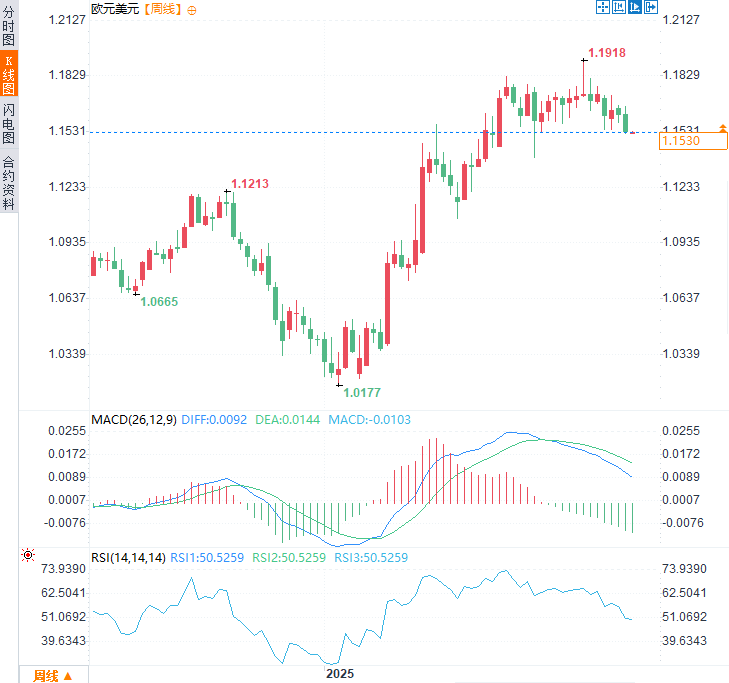Lagarde's "ideal position" theory couldn't withstand the dollar storm! When will the euro, under pressure, turn bullish?
2025-11-03 11:58:15

The euro/dollar pair fell for three consecutive trading days last week, hitting a near three-month low of 1.1521 in the previous session, before trading in a narrow range around 1.1530 on Monday (November 3). However, the downside is expected to be limited, with the 1.15 support level clearly visible.
The US dollar had previously experienced a strong week.
Federal Reserve Chairman Jerome Powell's hawkish remarks at the press conference provided strong support for the dollar, as he remained cautious about a policy shift in December.
More importantly, the trade agreement removed a long-standing source of negative uncertainty that had plagued the dollar. Traders were also reluctant to short the dollar due to the lack of sufficiently significant negative news from the US.
The ongoing government shutdown means the Federal Reserve will lack key employment market data for its December interest rate decision. Given the lack of data releases, it remains to be seen how much further the dollar can rebound.
The European Central Bank is in an ideal position.
Last week, despite strong Eurozone GDP data and the European Central Bank signaling that it was "in an ideal position," it failed to prevent the euro/dollar exchange rate from falling due to a stronger dollar.
European Central Bank President Christine Lagarde said at a press conference last week: "From a monetary policy perspective, we are in an ideal position. Is this fixed? No, but we will take all necessary measures to ensure that this ideal position is maintained."
This statement suggests that, unless there are unexpected changes in subsequent data, the European Central Bank has essentially completed its current rate-cutting cycle. This policy stance is expected to provide a floor for the euro/dollar exchange rate.
Key data highlights for EUR/USD forecast
Looking at Eurozone data, this week isn't particularly crucial. Monday will see the final manufacturing PMI figures for France and Germany. Lagarde will speak again on Tuesday. If she discusses monetary policy, her tone is expected to remain consistent with last week—after all, what reason would there be to change it? Wednesday's focus will be on German factory orders and the final Eurozone services PMI. Thursday will see attention on German industrial production and Eurozone retail sales data. Friday will feature some trading data.
Regarding the US, while no government data will be released, the market will receive private sector data, including the ISM Purchasing Managers' Index—the manufacturing PMI will be released on Monday, the services PMI on Wednesday, and the ADP private sector employment report will also be released on Wednesday. These private sector data releases (especially the ADP report) have a significant impact on the dollar's performance, as the Federal Reserve has shifted its policy focus to employment indicators within its dual mandate, and recent weakness in this area has allowed it to implement interest rate cuts (most recently last Wednesday). Unless employment improves significantly and inflation picks up, a December rate cut is still possible—even though Powell has stated that this is not a certainty.
EUR/USD Technical Forecast
From a technical perspective, the euro/dollar pair remains range-bound, but the long-term outlook may still be bullish – despite weakening upward momentum.
With the euro/dollar pair closing at a 13-week low (1.1535) this week, it may face further short-term declines.
On the downside, the key short-term support is currently around 1.1500. A break below this level could lead to a test of the August low of 1.1391.
On the upside, the resistance levels are 1.1580 and 1.1600 respectively.

(Euro/USD weekly chart, source: FX678)
At 11:57 Beijing time, the euro was trading at 1.1532/33 against the US dollar.
- Risk Warning and Disclaimer
- The market involves risk, and trading may not be suitable for all investors. This article is for reference only and does not constitute personal investment advice, nor does it take into account certain users’ specific investment objectives, financial situation, or other needs. Any investment decisions made based on this information are at your own risk.





















